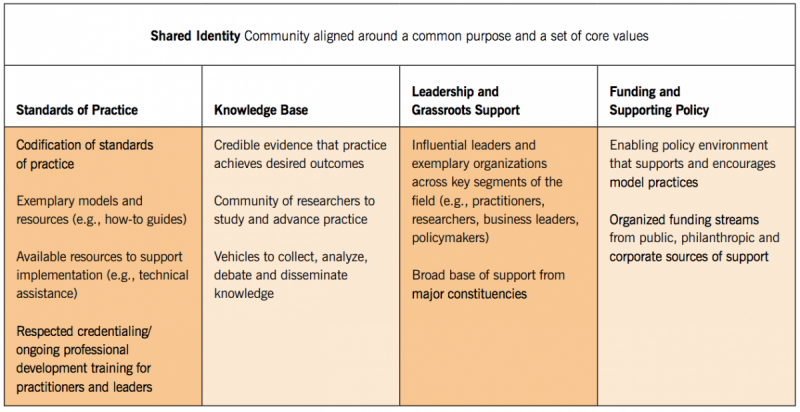
Introduction
ArtPlace was set up to further encourage a world in which arts and cultural strategies are used in solving community planning and development challenges. To realize this challenge we believe that a critical mass of organizations and individuals must be aligned and working effectively as a field. That’s why field building is a key component of our work to create this social change. To understand how to focus our field building investments and activities moving forward, we needed a comprehensive and cohesive map of the strengths and weaknesses of our field.
In January 2018, ArtPlace, in partnership with Arizona State University, the Kresge Foundation, and the National Endowment for the Arts, decided to study the strength of the creative placemaking field.
We asked The Bridgespan Group to assess the strengths and needs of the field using their Strong Field Framework.

Methodology
To assess the strength of the creative placemaking field, The Bridgespan Group used a two-pronged approach.
First, they interviewed 47 individuals about their perception of the creative placemaking field. 34 of these interviews were of individuals who are colleagues of the partners and involved in the creative placemaking field. Thirteen of the individuals were with individuals who are not as close to the work or as some would describe as “out of the tent”. The protocol that they used for these interviews can be found here.
Second, they created a field assessment survey that was distributed using a convenience sampling (samples are selected because they are accessible to the researcher/easy to recruit and are not representative of the population) method. Over 3,300 individuals responded to this survey which can be found here.
Findings
What did we learn?
The study demonstrated that we have steadily developed a shared identity among a group of practitioners who would not have previously defined their work as being part of the same field. In addition, we have added both to a knowledge base and to standards of practice, and we have been able to identify, support and engage leaders, practitioners, funders and policymakers. There are many indicators of our achievements as a field – university courses in creative placemaking; public agencies and private philanthropies beyond the ArtPlace partnership using creative placemaking as a frame for grantmaking; and recently a national series of regional creative placemaking convenings was launched. Yet there is still more to be done!
Six broad priorities are shared for the creative placemaking field:
- Explicitness and transparency about the assumptions, values and hypotheses that people bring to the work, specifically about what it means to develop equitable, healthy and sustainable communities.
- A shared understanding of how those inform the set of outcomes toward which we are working, as well as the relevant formative assessment frameworks that can be easily deployed and understood.
- Practical project-level resources that are relevant, useful and actually used.
- Leaders who are native to this cross-sectoral way of working and who come from the communities in which the work is happening.
- Broad adoption of ongoing partnerships with the arts and culture sector by the community planning and development sector.
- Flexible and supportive funding and policy.
The results that we found the most interesting can be viewed in this PowerPoint. There are many findings presented, but not everything. If you are a data wonk or have a specific question you think these data can help you answer, you can explore the raw data here. You can also contact us to ask more questions too!
The Strong Field Framework has five components: shared identity, standards of practice, knowledge base, leadership and grassroots support, and funding and supporting policy. Each is further described as follows, then summarized in the chart above.
Shared Identity: A shared identity is the foundation for any field of practice, without which individuals and organizations with similar motivations and goals may end up working in isolation or at cross-purposes. Do those working in the field identify as members of a field? Are they clear about what the field is collectively trying to accomplish? How well do diverse and distinct individuals and organizations in the field collaborate? Are there common approaches and practices to achieving an overall goal? As the accompanying graphic shows, “shared identity” is an overarching component binding the other components in common purpose.
Standards of Practice: Classically, fields (like medicine or law) are comprised of trained practitioners who are engaged in an area of specialized practice. The same should be true for strong fields engaging in social change. Does the field have codified practices? Are there demonstration models that members of the field are aware of? How well developed are the training and professional development programs that support practitioners? Are there established processes and organizations to ensure the quality and fidelity of implementation?
Knowledge Base: It takes credible research that confirms the efficacy of core practices to strengthen a field. How well developed is this evidence and knowledge base? Are there experts who research the field? How engaged are these experts and practitioners with the ongoing improvement of the field? How well is knowledge documented and disseminated within the field?
Leadership and Grassroots Support: To build and sustain a field, leadership and grassroots support are critical. Are there influential leaders and exemplary organizations working to advance the field? Is there a broad base of support from key constituencies?
Funding and Supporting Policy: Dedicated funding, along with supporting policy, can foster the development of a field. Is there sufficient funding for the field to achieve its goals? Is the policy environment supportive? Is the field actively involved in helping to develop the policy environment?





